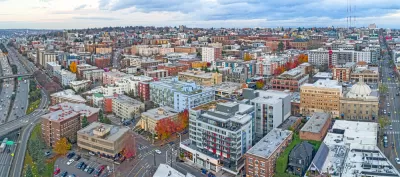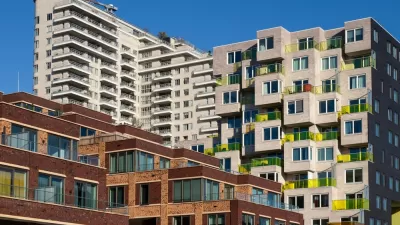Supporters of ‘point access blocks,’ which are common in Europe and other parts of the world, say the design maximizes living space and lowers the cost of construction.

A bill proposed in the Washington State Senate would legalize “point access blocks,” a type of multi-story building with a single stairway and elevator that supporters argue would allow for more affordable housing construction. Writing in The Urbanist, Mike Eliason explains why he supports the bill, outlining the benefits of one-staircase buildings for affordability and building design.
While single-staircase construction is allowed by international building code and common in many parts of the world, many U.S. cities require two staircases as a fire safety measure. Meanwhile, Seattle is the only U.S. city to have adapted its code to allow point access blocks for buildings up to five stories (six for mixed-use projects), provided they meet other safety regulations.
The proposed bill, SB 5491, would allow all other Washington cities to adopt Seattle’s model. Eliason writes, “I believe that allowing taller point access blocks statewide will unlock more small-scale development without the need for parcel assemblage, a process which increases costs and time of development.” For Eliason, the bill could also create the potential for more diverse housing types between ‘missing middle’ housing and larger developments and make it easier to build larger units appropriate for families and larger households. “They also increase opportunities for small property owners, homeowners, small developers, community land trusts, and coops to meet today’s housing needs — groups typically unable to do large scale, well-capitalized projects.”
FULL STORY: One Stairway is Enough to Reach Housing Heaven

Alabama: Trump Terminates Settlements for Black Communities Harmed By Raw Sewage
Trump deemed the landmark civil rights agreement “illegal DEI and environmental justice policy.”

Planetizen Federal Action Tracker
A weekly monitor of how Trump’s orders and actions are impacting planners and planning in America.

The 120 Year Old Tiny Home Villages That Sheltered San Francisco’s Earthquake Refugees
More than a century ago, San Francisco mobilized to house thousands of residents displaced by the 1906 earthquake. Could their strategy offer a model for the present?

USDOT Repeals Emissions Monitoring Rule
A Biden-era regulation required states to report and plan to reduce transportation-related emissions.

CaBi Breaks Ridership Record — Again
Washington D.C.’s bike share system is extremely popular with both residents and visitors.

San Francisco Opens Park on Former Great Highway
The Sunset Dunes park’s grand opening attracted both fans and detractors.
Urban Design for Planners 1: Software Tools
This six-course series explores essential urban design concepts using open source software and equips planners with the tools they need to participate fully in the urban design process.
Planning for Universal Design
Learn the tools for implementing Universal Design in planning regulations.
Clanton & Associates, Inc.
Jessamine County Fiscal Court
Institute for Housing and Urban Development Studies (IHS)
City of Grandview
Harvard GSD Executive Education
Toledo-Lucas County Plan Commissions
Salt Lake City
NYU Wagner Graduate School of Public Service





























